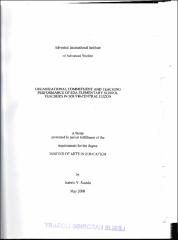Organizational commitment and teaching performance of SDA Elementary School Teachers in South-Central Luzon
Abstract
This study investigated potential relationships between the organizational commitment and teaching performance of Seventh-day Adventist elementary school teachers in South-Central Luzon. This involved 123 teachers from 30 elementary schools under the administrative supervision of the South-Central Luzon Conference during the year 2007-2008.
The organizational commitment, measured by the organizational commitment questionnaire was considered as commitment to the Seventh-day Adventist educational system while the teaching performance was taken as a result of four evaluations: namely, peer teacher’s evaluation, principals' teacher evaluation, teacher' self-evaluation, and this researcher’s teacher evaluation using the teaching performance evaluation instrument.
The organizational commitment questionnaire results revealed a mean of 5.52 (7 point Likert scale) within the agreement range "Moderately Agree" and a mean of 3.40 (5 point Likert scale) within the "Very Good" evaluation range for the teaching performance. The principal evaluation obtained the lowest mean (M= 3.45, SD= 0.44) and the self-evaluation made by the teachers produced the highest mean (M = 4.40, SD= 0.36) while this researcher evaluation mean (M = 3.87, SD = 0.29) was closer to the principal's and the peer's (M = 4.22, SD= 0.44) was closer to the self-evaluation. The strongest
Association was between the peer and researcher evaluation (r = 0.5), a moderate positive correlation. The correlation between the peer evaluation and the self-evaluation was positive but low (r = 0.19). The principal's evaluation was not correlated to the evaluation of others.
Analysis in the findings in the differences between groups formed using demographic variables and teaching performance revealed that females were generally evaluated to have a higher performance evaluation in teaching than males. Two evaluators-the principal and this researcher-are most sensitive to distinguishing gender differences in performance. However, they usually perceived these differences in different areas of performance.
Age differences in performance were acknowledged by all evaluators but while self-evaluation and principal evaluations favored higher performance by older teacher particularly for items about teacher qualifications and the management and guidance skills, the peers tended to disagree particularly for items pertaining to teaching skills and the personal and social skills. This researcher's opinions varied by teaching task or attribute.
',
While the principal did not indicate any differences for class structure, it was differentiating in the self-evaluations. The multigrade teachers rated themselves to be higher in their performance, particularly in evaluation skills, while the peers perceived the single grade teachers to be better particularly in teaching skills.
The lone variable entering the predictive model of teaching performance was
organizational commitment. This variable accounted for 4. 3% of the variance explained in teaching performance.
Recommendations include programs for enhancing the organizational commitment of the teachers, retention of male teachers in the teaching profession so as to achieve equality between the male and female teachers, and equating high qualification of teachers with their teaching skills. The school system is also encouraged to develop evaluation policies which include establishing performance standards for the teachers, using a reliable teaching performance evaluation instrument and training of teachers and administrators as effective evaluators.


